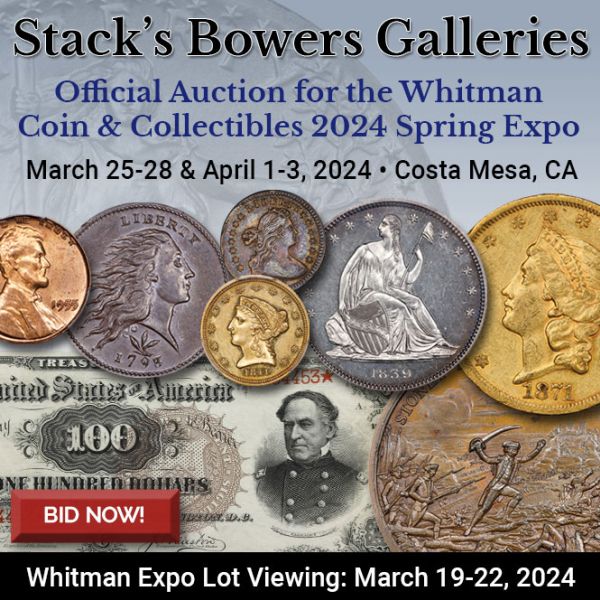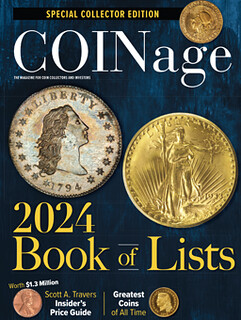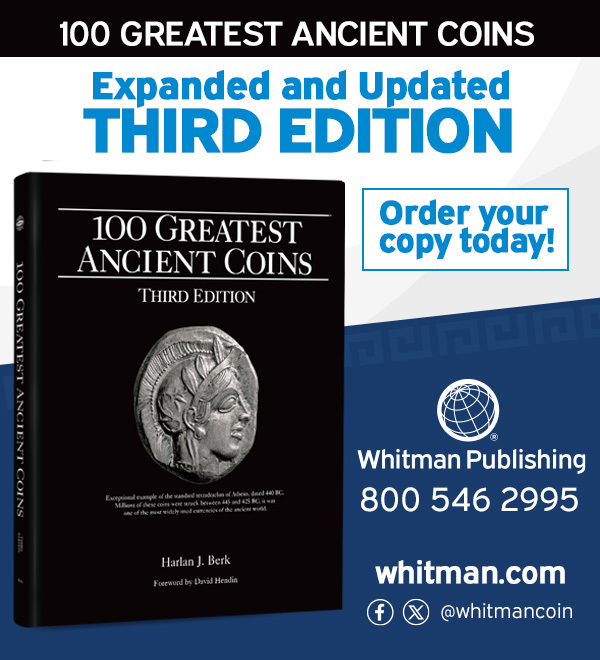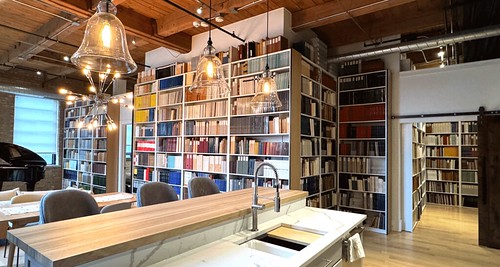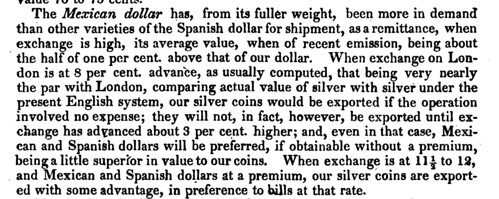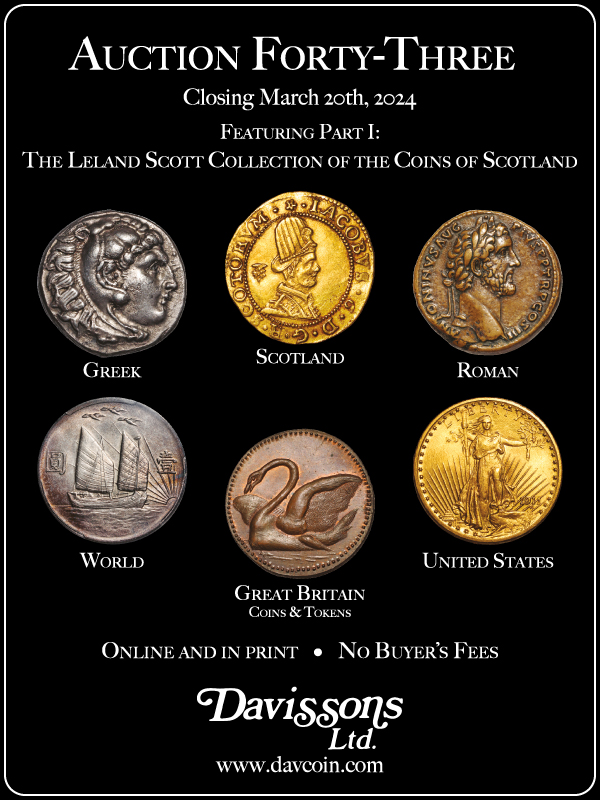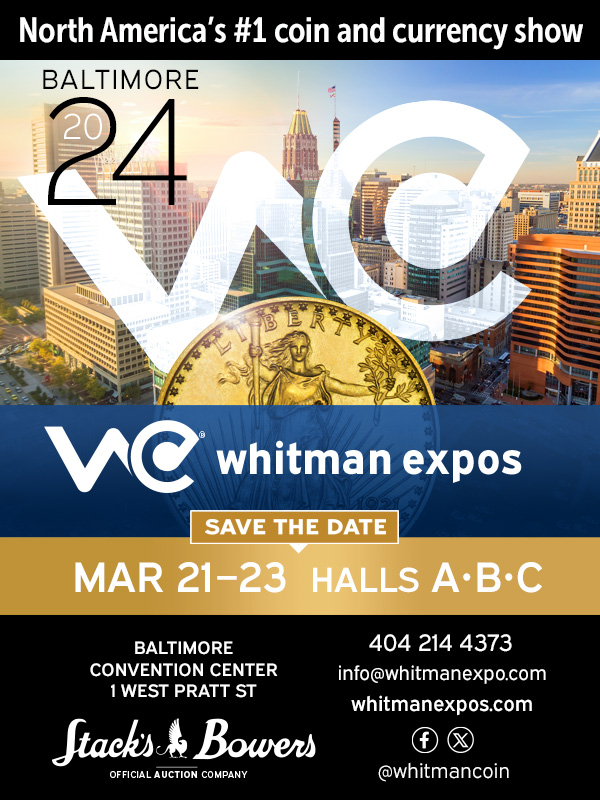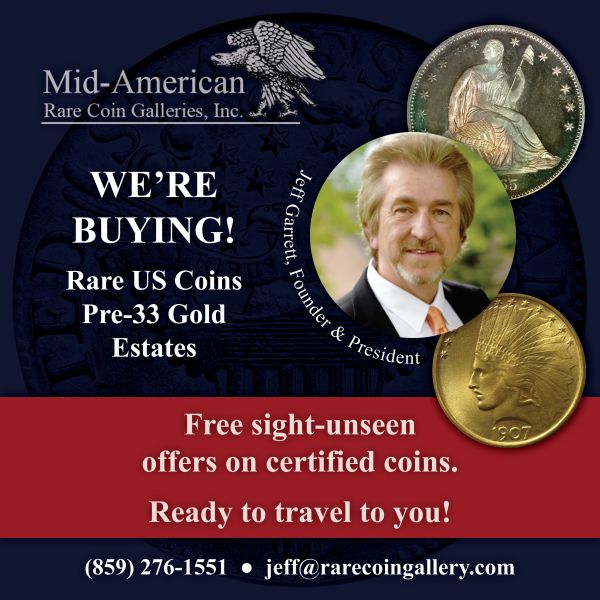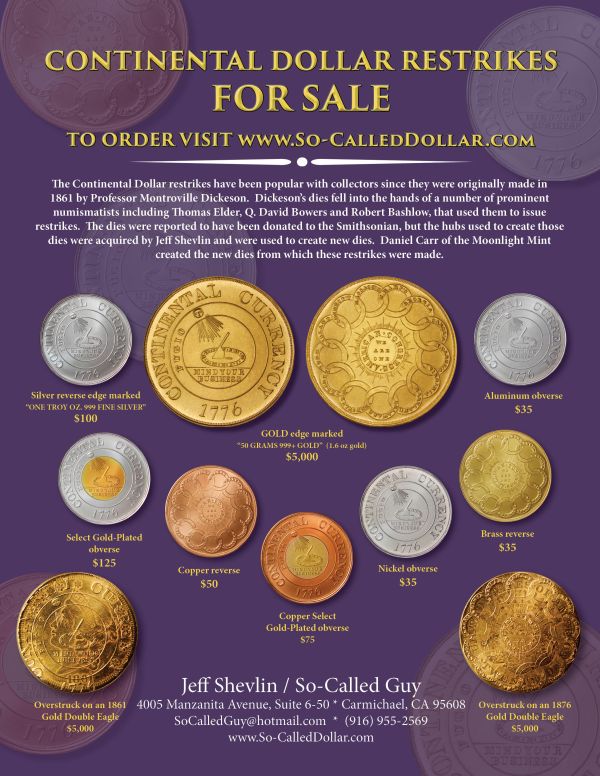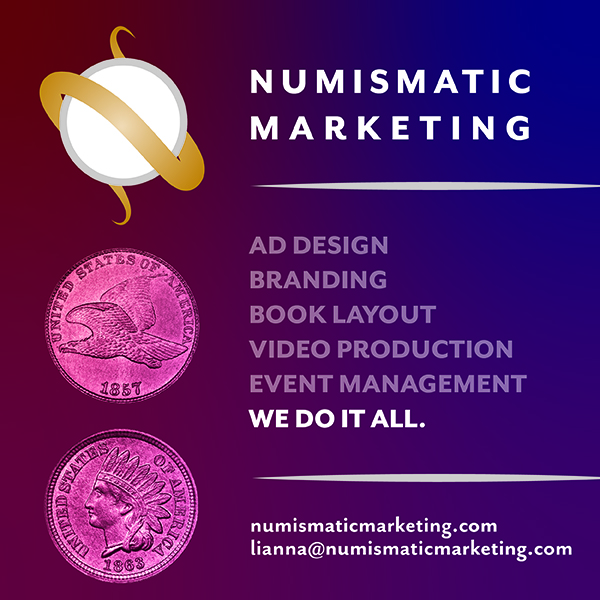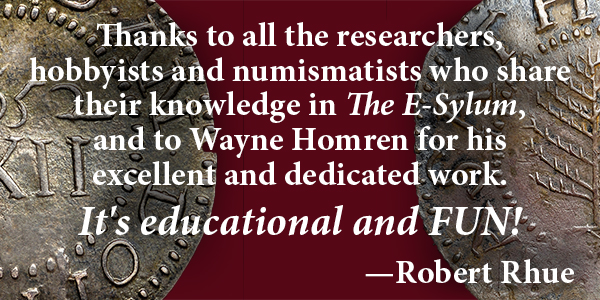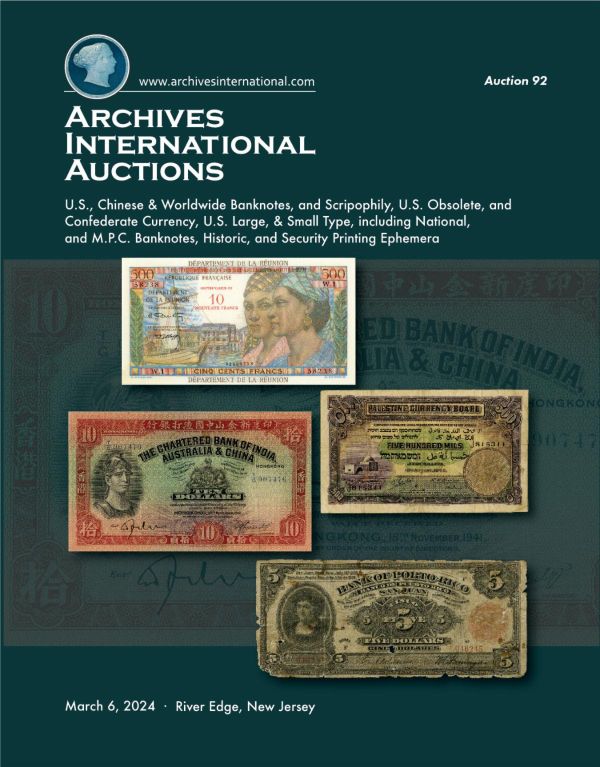
Visit our NBS Sponsors
About UsThe Numismatic Bibliomania Society is a non-profit association devoted to the study and enjoyment of numismatic literature. For more information please see our web site at coinbooks.org SubscriptionsThose wishing to become new E-Sylum subscribers (or wishing to Unsubscribe) can go to the following web page link MembershipThere is a membership application available on the web site Membership Application To join, print the application and return it with your check to the address printed on the application. Print/Digital membership is $40 to addresses in the U.S., and $60 elsewhere. A digital-only membership is available for $25. For those without web access, write to: Jeff Dickerson, Treasurer AsylumFor Asylum mailing address changes and other membership questions, contact Jeff at this email address: treasurer@coinbooks.org SubmissionsTo submit items for publication in The E-Sylum, write to the Editor at this address: whomren@gmail.com BUY THE BOOK BEFORE THE COINSale CalendarWatch here for updates! |
- WAYNE'S WORDS: THE E-SYLUM MARCH 3, 2024
- NEW BOOK: COINAGE 2024 BOOK OF LISTS
- BANKNOTE BOOK TIBET CHAPTER PUBLISHED
- JACOB ROTHSCHILD (1936-2024)
- 1862 JOSEPH J. MICKLEY LETTER
- NEWMAN PORTAL DIGITIZATION WORKFLOWS
- VIDEO: ANS CLAPP COLLECTION LARGE CENTS
- S&S LIBRARY UPDATE
- MORE ON THE SPANISH-U.S. DOLLAR TRADE
- MORE ON WALTER JOHNSON'S DOLLAR THROW
- NOTES FROM E-SYLUM READERS: MARCH 3, 2024
- CLAIN-STEFANELLI'S NUMISMATICS - AN ANCIENT SCIENCE
- 1870S EMPEROR NORTON MARKET FORECASTS
- VOCABULARY TERM: PERSONAL MEDAL
- STANLEY THOMAS KIRBY (1940-2005)
- ANS 2023 HUNTINGTON AWARDEE: RUTH PLIEGO
- CENTRAL STATES INAUGURAL STATE SHOWCASE
- NUMISMAGRAM MEDAL SELECTIONS: MARCH 3, 2024
- 2024 MADISON COUNTY COIN CLUB MEDAL AVAILABLE
- STACKS OFFERS SLOVICK INDIAN PEACE MEDALS
- COINS OF THE HOUSE OF VALENTINIAN
- OXFORD POUND OFFERED
- 1723 SOUTH SEA COMPANY SHILLING
- KING CHARLES III 2024 MAUNDY COIN PLANS
- BINION 1934 $10,000 BILL OFFERED
- $100 BILL, AMERICA'S MOST ANNOYING CURRENCY
- SO WHO'S USING ALL THE CASH?
- THE BIRTH OF A (PSEUDO) CURRENCY
- LOOSE CHANGE: MARCH 3, 2024
- DELHI MAN SWALLOWS 39 COINS... AND MORE!
Content presented in The E-Sylum is not necessarily researched or independently fact-checked, and views expressed do not necessarily represent those of the Numismatic Bibliomania Society.
WAYNE'S WORDS: THE E-SYLUM MARCH 3, 2024
 Thank you for reading The E-Sylum. If you enjoy it, please send me the email addresses of friends you think may enjoy it as well and I'll send them a subscription. Contact me at whomren@gmail.com anytime regarding your subscription, or questions, comments or suggestions about our content.
Thank you for reading The E-Sylum. If you enjoy it, please send me the email addresses of friends you think may enjoy it as well and I'll send them a subscription. Contact me at whomren@gmail.com anytime regarding your subscription, or questions, comments or suggestions about our content.
This week we open with two new books, a billionaire obit, updates from the Newman Numismatic Portal, notes from readers, and more.
Other topics this week include Joseph Mickley, George Clapp, Walter Johnson, Elvira Clain-Steffanelli, Emperor Norton, Stan Kirby, Ruth Pleigo, the Central States Numismatic Society, fixed price and auction offerings, Indian Peace medals, the South Sea Company shilling, Maundy coins, Binion bills, and pseudo currency.
To learn more about Government of Tibet paper money, the S&S Library, the Roosevelt "Lucky Tillicum" coin, personal medals, Tri-State Coin Supply, the Peace of Nystadt medal, coins of Valentinian, America's most annoying currency, the Numismatica Domestica Club, Tesla's stolen head, and the Super Bowl LVIII Flip Coin, read on. Have a great week, everyone!
Wayne Homren
Editor, The E-Sylum
NEW BOOK: COINAGE 2024 BOOK OF LISTS
COINage has published a new book of lists. -Editor
COINage 2024 Book of Lists
$12.99
- Insider's guide to U.S. coin values and mintage figures for the greatest rarities and all the popular coins, by Scott A. Travers, fully updated for 2024
- Comprehensive lists of coin dealers and auction companies plus coin clubs and organizations
- Best deals in trading coins and charting values
- Top six vintage commemorative coins
- David Hall's greatest coins of all time
- Top five U.S. coins for fun and profit
- Exclusive: Photographic guide to grading silver American Eagle 1-oz bullion coins
- Coin collecting 101 with coin market directions and how to profit
- The case for gold and silver as currency and as an alternative investment
- Coin treasures buried at sea worth millions
For more information, or to order, see:
https://www.coinagemag.com/product/books/
BANKNOTE BOOK TIBET CHAPTER PUBLISHED
A new chapter of The Banknote Book has been published by Whitman-CDN. Written by Owen Linzmayer, the 8-page catalog covers 40 varieties of notes from the Government of Tibet from 1912 – 1950. -Editor
To read the complete article, see:
Tibet chapter now available
(https://banknotenews.com/?p=43190)
JACOB ROTHSCHILD (1936-2024)
Passing along a New York Times obituary, Jeff Zarit writes:
"This well-known family started as a coin dealer. In our industry, it is good to remember that."
 Jacob Rothschild, a wealthy financier, patron of the arts and philanthropist with close ties to Israel, who broke with his family's fabled banking dynasty at a time of radical change in the world of high finance, has died. He was 87.
Jacob Rothschild, a wealthy financier, patron of the arts and philanthropist with close ties to Israel, who broke with his family's fabled banking dynasty at a time of radical change in the world of high finance, has died. He was 87.
His death was announced on Monday by the Rothschild Foundation, a British charity of which he was the chairman. It did not specify when or where he died or give the cause of death.
Mr. Rothschild — more formally the fourth Baron Rothschild — was descended from Mayer Amschel Rothschild, a coin trader in the Jewish ghetto in Frankfurt, who sent four of his five sons to Vienna, London, Naples and Paris to seek their fortune in the late 18th and early 19th centuries.
For most of the 19th century, the House of Rothschild was the biggest bank in the world by a wide margin,
Jonathan Steinberg, an American scholar, wrote in The London Review of Books in 1999. The fortune of Nathan Mayer Rothschild, the son who founded the bank's London branch, can be compared to that of Bill Gates today,
Mr. Steinberg added.
Most accounts of the Rothschilds' wealth trace its origins to a decision to finance the British military in the Napoleonic Wars. But the broader dynasty flourished on cementing its family bonds and cultivating what Mr. Steinberg called everybody who was anybody at the top of European society during this period.
It was against this historical backdrop that Jacob Rothschild joined the London arm of the family's empire at the N.M. Rothschild & Sons bank in 1963. Until then he had followed a route familiar to the British elite, educated at Eton College and at Christ Church, Oxford.
Mr. Rothschild retired as head of RIT Capital Partners in 2019. That year, his personal wealth was estimated by the Bloomberg Billionaires Index to be more than $1 billion.
Nathaniel Charles Jacob Rothschild was born in Berkshire, England, on April 29, 1936, to Victor Rothschild, the third Baron Rothschild, and his first wife, Barbara Judith (Hutchinson) Rothschild.
To read the complete article, see:
Jacob Rothschild, Banker Who Broke From His Fabled Family, Dies at 87
(https://www.nytimes.com/2024/02/26/business/jacob-rothschild-dead.html)
1862 JOSEPH J. MICKLEY LETTER
Newman Numismatic Portal Project Coordinator Len Augsburger provided the following report about a rare letter from collector Joseph J. Mickley coming up for sale at Heritage. -Editor
Eric P. Newman Correspondence Files Showcase Auction Features 1862 Joseph J. Mickley Letter
Now open for bidding, Heritage Auctions is offering Selections from the Eric P. Newman Correspondence Files, a Showcase Auction which closes on March 25. Among the 97 lots is a two-page letter (lot #52083) from the Philadelphia numismatist Joseph J. Mickley, dated March 19, 1862, in which Mickley comments on coin prices.
The letter, signed by Mickley and addressed to Francis Lepère, notes in part the price of American coins has gone up very high within several years past, owing to there being a great many Collectors and to our old coins being recoined, the old Copper Cents and Halves disappearing from circulation rapidly.
The reference to halves
no doubt indicates half cents. As other authors have noted, the introduction of small cents in 1856 led many Americans to being examining their pocket change, especially large cents, and the overall coin consciousness
of the American public grew steadily, especially on the east coast.
Newman published a transcription of this article in Coin World, October 29, 1969, a clip of which is included with this lot. Nothing is known of how Newman acquired the Mickley letter, although the St. Louis connection may have played a part. Francis Lepère appears as a St. Louis grocer in the 1850 and 1870 censuses and is likely the identity of Mickley's correspondent. As a grocer, he would have handled small change, an ideal situation for a coin collector of that era. The Coin Collector's Journal of September 1876 mentions Francis Lepere, of St. Louis.
Lepère was further a named consignor to the July 17-18, 1876, sale of the dealer John Haseltine and to the February 15-16, 1904, sale of S. H. & H. Chapman. Given the paucity of numismatists in St. Louis in the Civil War era, this letter would certainly have piqued Newman's interest.
Image: Extract from Joseph J. Mickley letter to Francis Lepère, March 19, 1862
Link to the Joseph J. Mickley letter at Heritage Auctions:
https://coins.ha.com/itm/miscellaneous/mickley-joseph-j-holograph-letter-signed-dated-march-19-1862-and-addressed-to-francis-lepere-written-on-both-sides-of-one-sheet-of/a/63247-52083.s?ic4=ListView-ShortDescription-071515
Link to the Newman Correspondence Files Showcase Auction sale home page:
https://coins.ha.com/c/auction-home.zx?saleNo=63247&ic=breadcrumb-coins-121913-interior
Link to John Haseltine sale of the Francis Lepere collection, July 17-18, 1876:
https://nnp.wustl.edu/library/auctionlots?AucCoId=510907&AuctionId=511584
Link to S.H. & H. Chapman sale including material from Francis Lepere,
https://nnp.wustl.edu/library/auctionlots?AucCoId=21&AuctionId=510894
To read earlier E-Sylum articles, see:
FEATURED WEB PAGE: JOSEPH MICKLEY'S DIARY
(https://www.coinbooks.org/esylum_v19n02a31.html)
LONG-LOST JOSEPH MICKLEY LETTER REDISCOVERED
(https://www.coinbooks.org/v20/esylum_v20n22a10.html)
JOSEPH MICKLEY MEMORIAL MEDAL AND ARCHIVE
(https://www.coinbooks.org/v22/esylum_v22n31a27.html)
NEWMAN PORTAL DIGITIZATION WORKFLOWS
The latest addition to the Newman Numismatic Portal is a video about the digitization process. Project Coordinator Len Augsburger provided the following report. -Editor
Digitization Workflows Within Newman Portal
As noted in the February 18 E-Sylum, we've mounted a series of numismatic exhibits in Olin Library at Washington University in St. Louis for the Spring 2024 semester. Included in the exhibit is a video, created by Ian Lanius, Exhibitions Graphic Designer & Preparator, which illustrates digitization workflows utilized at the library to process varying media. We depict examples of multispectral imaging, high resolution scanning, digitization of transparencies, book scanning with facing cameras, and microfilm digitization. This video is displayed without sound, with subtitles walking viewers through the various workflows.
Image: Close-up of Adolphus Hart plate of colonial paper money, scanned with the Digital Transitions Titan Copy Stand
Link to digitization video on Internet Archive:
https://archive.org/details/nnpexhibitspring2024video/nnpexhibitspring2024video+(streaming+version).mp4
Link to Coin Across Time February 18 E-Sylum announcement:
https://www.coinbooks.org/v27/esylum_v27n07a06.html
VIDEO: ANS CLAPP COLLECTION LARGE CENTS
The David Lisot Video Library on the Newman Numismatic Portal can be found at:
https://nnp.wustl.edu/library/multimediadetail/522852
We highlight one of his videos each week in The E-Sylum. Here's one from 2005 about the large cent collection George Clapp donated to the ANS. -Editor
Legendary collector George Clapp donated his world-class collection of large cents to the American Numismatic Society. Included were some of the finest examples of these coins available. Hear stories about this man who ran Alcoa and the coins that are part of his legacy from ANS Curator Robert Hoge.
Speaker(s): Robert W. Hoge.
I rarely pass up the chance to mention fellow members of my home club, the Western Pennsylvania Numismatic Society. Great coins! -Editor
To watch the complete video, see:
Rare Large Cents from the Geo. Clapp Collection in the ANS
(https://nnp.wustl.edu/library/book/560141)
S&S LIBRARY UPDATE
E-Sylum sponsor and NBS Board Member Shanna Schmidt published this library report in her Newsletter #211 yesterday. -Editor
The biggest achievement for me in the last few months was getting the BCD auction catalogs all on the shelves. It was no small feat and I feel compelled to thank a number of people who helped. The most important is my husband, Rainer, who helped to measure, design and coordinate construction of the bookshelves that house nearly 800 linear feet of catalogs. Next is Tyler Rossi, my dedicated and hardworking assistant, who unpacked hundreds of boxes, sometimes all on his own and put them up on the shelves in the correct order. Finally, my sons Jakob and Leo, who during their holiday break from studying, broke down those boxes and brought them out to the trash. It was a big affair but finally the library is starting to look like……well, a library!
Scanning project - Newman Numismatic Portal and S&S Library
I want to remind all my subscribers that there will be an excellent new opportunity for you to access numismatic literature for free. The Newman Portal (NNP) and S&S Library entered into a cooperation recently of historic proportions! We are scanning the entire S&S Library, currently close to 9,000 volumes and still growing, and making anything out of copyright available for public consumption. This will be transformative for the NNP as there will now be much more available on ancient coins than ever before. We aren't quite ready yet to give detailed information to you but be on the lookout for that. It will be a great way to access numismatic literature with a click of a button.
For more on Shanna Schmidt Numismatics, see:
https://www.shannaschmidt.com/
Here's an excerpt from the September 2023 announcement. -Editor
Newman Portal and S&S Library, LLC Team to Digitize Literature of Ancient Numismatics
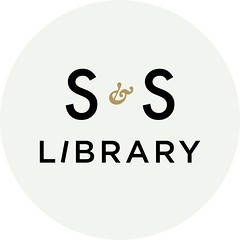 The Newman Numismatic Portal (NNP) and the S&S Library today announce an initiative to digitize over 6,000 volumes from the S&S Library, which is primarily focused on ancient numismatics. We are excited to expand the scope of our content to include world and ancient numismatics, said NNP Project Coordinator Len Augsburger. Shanna Schmidt, a partner in S&S Library, LLC noted The literature of numismatics began with ancient coins, and the appreciation of all numismatics will be enhanced by knowledge of our earliest coins. We are pleased to partner with Newman Portal on the broad scale digitization of the literature related to ancient numismatics.
The Newman Numismatic Portal (NNP) and the S&S Library today announce an initiative to digitize over 6,000 volumes from the S&S Library, which is primarily focused on ancient numismatics. We are excited to expand the scope of our content to include world and ancient numismatics, said NNP Project Coordinator Len Augsburger. Shanna Schmidt, a partner in S&S Library, LLC noted The literature of numismatics began with ancient coins, and the appreciation of all numismatics will be enhanced by knowledge of our earliest coins. We are pleased to partner with Newman Portal on the broad scale digitization of the literature related to ancient numismatics.
The S&S Library, housed in Chicago, is jointly owned by Shanna Schmidt Numismatics and a leading, U.S.-based collector in the field of classical and ancient numismatics. The library includes core holdings in all fields of numismatics, with a concentration on literature related to ancient coinage. Library highlights includes E. J. Haeberlin's Aes Grave (1910), Dattari's Monete Imperiali Greche (1901), and the first six volumes of The Numismatist (1888-1893), one of perhaps ten copies in private hands. The S&S Library was recently the subject of a video produced by Newman Portal, available at https://nnp.wustl.edu/library/book/630666.
To read the earlier E-Sylum articles, see:
BCD CATALOGS ARRIVE IN CHICAGO
(https://www.coinbooks.org/v26/esylum_v26n52a07.html)
NNP TO DIGITIZE LITERATURE OF ANCIENT NUMISMATICS
(https://www.coinbooks.org/v26/esylum_v26n39a09.html)
MORE ON THE SPANISH-U.S. DOLLAR TRADE
Craig Sholley and Harry Salyards submitted these additional notes on the fineness of the silver in early U.S. coinage and the exchange of U.S. silver dollars for Spanish dollars. -Editor
More On The Spanish Dollar-U.S. Dollar Trade
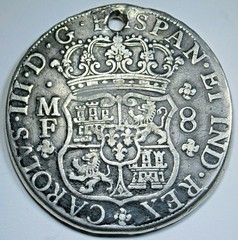 First, we wish to thank R.W. Julian for posting the 1797 letter from Secretary of the Treasury,
Oliver Wolcott, to the president and directors of the Bank of the United States, directing the
bank to send whatever gold or silver foreign coins they have to the mint for recoining, except
First, we wish to thank R.W. Julian for posting the 1797 letter from Secretary of the Treasury,
Oliver Wolcott, to the president and directors of the Bank of the United States, directing the
bank to send whatever gold or silver foreign coins they have to the mint for recoining, except
Spanish dollars & parts of such dollars.
Of particular interest to the subject at hand, is Wolcott's specific mention of the mint act
of
Feb. 9, 1793. That act made certain foreign coins legal tender, including Spanish dollars and
their cut parts. However, the act also clearly states that in order to be legal tender, the dollars
must weigh at least 415 grains (with cut parts in proportion).
The fact that Wolcott specifically cited the act truly cements our contention that few, if any, of the Spanish dollars deposited by the bank in 1800 through 1805 were full-weight, since doing so would have violated the Secretary's directive. In fact, in order to comply with the directive, the Spanish dollars deposited by the bank must have weighed less than 415 grains.
So, even if one proposes that the dollars deposited weighed, on average, 414.5 grains, since they assayed at .8924 to .8934, the dollars, on average, would have contained just 369.89 to 370.13 grains of silver – that's less than the 371.25 grains of silver in a U.S. dollar!
Since the Bank of the United States was the only entity depositing any significant quantity of
Spanish dollars prior to 1806, the fact that the dollars deposited actually contained less silver
than a U.S. dollar simply destroys the myth that huge numbers of U.S. dollars were exchanged
for heavier
Spanish dollars in the Caribbean and then supposedly returned to the mint for
recoining at a profit.
It could be suggested that the supposed dollar-for-dollar arbitrage trade story became muddled over time and what really took place was a trade of two U.S. half dollars for Spanish dollars from 1806 on, when there were numerous large deposits of Spanish dollars by several entities. Or it could be suggested that U.S. banks had hoarded U.S. dollars as specie backing for loans until 1806 and the trade actually took place then.
No matter, the tale still does not work since the Spanish colonial dollars deposited from 1806
through 1810 or so, all assayed at a maximum of .8957 fine. So, even if the Spanish dollars
deposited in 1806 on all weighed the full standard of 417.7 grains, they contained just 374
grains of pure silver. That is less than eight-tenths of a percent more than the 371.25 grains of
silver in a dollar's worth of U.S. coins - far too little to cover the shipping and insurance costs of
the trade, not to mention what an exchange agent
in the Caribbean would cost.
In fact, it is not until well into the period of the First Mexican Republic that the Mexican dollars
were of a weight and fineness consistent enough to permit this mythical trade and that is well
after the story first appears in 1831. In sum, the storied Caribbean dollar-for-dollar arbitrage
trade
is nothing more than a fanciful tale, concocted well after it supposedly took place.
Craig Sholley adds:
I would love to know how this tale got started. Harry found the ref to a version of the tale appearing in 1831 and Eckfeldt and Dubois alluded to it in their 1842 tome (see page 83, where they state, The difference, though not appreciable in ordinary currency, makes a considerable gain upon recoinage in large sums.
).
So, it does appear to be a "mint myth" by at least the early 1830s.
It may have its genesis in the 1829 "report where Moore discusses which coinage is preferred for international trade."
Report from the Secretary of the Treasury Respecting the relative value of Gold and Silver. &c. May 29, 1830
Craig continues:
This whole subject is absolutely fascinating. Like most, I had simply read what Taxay wrote (pg. 125) and took it for granted. Geez, the guy had access to the mint and records. Why not believe him?
It was Harry who emailed me pointing out that if there was this trade going on, then where were all the deposits of Spanish dollars when USD were actually being struck?
Unless one counts deposits shown as "Coins of Spain," there are none prior to 1800 and not much through 1805. Even if the "Coins of Spain" deposits are counted as Spanish dollars (which is doubtful given the assays), they don't amount to much more than 20K - hardly a massive trade.
So, just looking at the quantity of supposed Spanish dollars deposited through 1805, the story makes no sense. And, once we started calculating the fineness, the story made even less sense.
This story certainly should have questioned much sooner since it makes little sense economically or logistically. First, what merchant is gonna send USD to the West Indies for exchange with a supposedly heavier SD and make just one percent or so after expenses when buying goods like rum, molasses, sugar, spices, tobacco, etc. would yield a far higher profit?
Further, whomever was doing the supposed trade would have to make sure that the SDs weighed at least 417 grains on average and assayed above .900 or the difference in pure silver would not be great enough to cover the costs of return shipping, insurance, and someone to gather and check the SDs.
And, since a full assay would be necessary to ensure the proper amount of silver, the coins would be returned as ingot, not SDs. Since, the trade also needs to cover assay costs, there really was no profit to be had even if the coins were full-weight at 417.7 grains and really did contain 377 grains of pure silver.
While there are deposits of "ingots" by private merchants such as John Vaughan and James Swann, the assays are "all over the place" from .879 to .998. Thus, the ingots deposited were agglomerations of various forms of silver accumulated by merchants and banks for use in international trade, specie backing of bonds and bills, and/or waiting for the mint to commence coining.
The real shame in all of this was the impugning of Hamilton. Here's a guy that turned out to be the financial genius who figured a way to pay the war debt without bankrupting the country.
Nonetheless, for the past 150 years he's been labeled as an unknowledgeable guy who got fooled by "bad assays" and misassumptions about the world gold-to-silver ratio, and thus chose the "wrong" standard for our early coinage. And most of us accepted these tales without one iota of proof. Shame on us.
To read the earlier E-Sylum articles, see:
ALEXANDER HAMILTON AND SILVER FINENESS
(https://www.coinbooks.org/v27/esylum_v27n05a12.html)
MORE ON HAMILTON AND SILVER FINENESS
(https://www.coinbooks.org/v27/esylum_v27n06a10.html)
FURTHER ON HAMILTON AND SILVER FINENESS
(https://www.coinbooks.org/v27/esylum_v27n07a07.html)
FURTHER ON HAMILTON AND THE GOLD/SILVER RATIO
(https://www.coinbooks.org/v27/esylum_v27n08a16.html)
MORE ON WALTER JOHNSON'S DOLLAR THROW
Readers have come up with more thoughts and reports relating to Walter Johnson's reenactment of the old George Washington story about throwing a silver dollar across the Rappahannock River. -Editor
Brian Healy of Walnut Creek, California writes:
"February 25 2024 E-Sylum had a short article about "Walter Johnson's Silver Dollar Throw" which mentioned a "Roosevelt Dollar".
"Could the coin have been one of Franklin Roosevelt's "Lucky Tillicum" election tokens? The E-Sylum issue of October 17, 2021 had an article about the "Lucky Tillicum"."
Seems very possible. Brian kindly included this image and description of the piece. Thanks. -Editor
Franklin D. Roosevelt "Lucky Tillicum" Coin
White metal, 27 mm, 8.28 gm
Obverse:
Franklin D. Roosevelt facing left
LUCKY TILLICUM / REBUILD WITH ROOSEVELT
Reverse:
Map of the United States with sunrise behind it.
PROSPERITY / 1933 / FOLLOW THE ROOSEVELT TRAIL
Julia Casey looked in newspapers and discovered two competing claims to the ownership of the piece Johnson threw. -Editor
Julia writes:
"I started looking into this and found all sorts of things! So far I have not discovered the outcome of that dispute or a description of what type of dollar coins were used. But something I found interesting was the engraving said to be on the dollar is different from what is typically reported. I found a 1936 contemporary article that states the same engraving as what was reported in the 1955 description."
Julia adds:
"Oh wow, I just found the newsreel video! It was a Peace Dollar."
Super, thanks! Check out the video, folks. Still questions, though. Johnson had some practice throws before the big event, so more objects were involved that day. And where is the coin today? -Editor
To watch the newsreel video, see:
Washington Senators' pitcher Walter Johnson throws silver dollar across Rappahannock River, 1936
(https://www.gettyimages.ie/detail/video/by-george-he-did-it-george-washington-legend-proved-a-news-footage/1269900416)
To read the earlier E-Sylum articles, see:
1933 ROOSEVELT LUCKY TILLICUM TOKEN
(https://www.coinbooks.org/v24/esylum_v24n42a25.html)
WALTER JOHNSON'S SILVER DOLLAR THROW
(https://www.coinbooks.org/v27/esylum_v27n08a33.html)
NOTES FROM E-SYLUM READERS: MARCH 3, 2024
More on New Orleans Mint Gold
Rich Kelly and Nancy Oliver write:
"In the February 18, 2024 issue you presented an article from Tom Hoke on "Mislabeled History - a Billion Dollar Mistake" and in addition there was a discussion of the buried Confederate gold mystery. You added that you would be interested in anything further - well, we might have something.
In our June 2012 column for The Numismatist, we wrote of such an event, used material from Tom Hoke's book, and some from the Philadelphia Inquirer, other sources and put it together. The title of the column was "Stolen Gold", and it was in depth on the mystery."
From the article:
The Civil War story of murder, a Confederate deserter and a stash of coins raises some interesting questions.
IN APRIL 1863, the American Civil War was raging across a large portion of our beleaguered nation. At the time, Union forces were trying to take Brashear City, Louisiana, one of the many towns in contention. An interesting incident occurred there involving a Confederate soldier who had abandoned his unit and was arrested by Union troops as he crossed enemy lines. This deserter was discovered to have quite a hoard of U.S. coins, and the story he told to explain it is rather intriguing.
Thank you. The Numismatist piece references a March 28, 1863 Philadelphia Inquirer article with the soldier's buried gold story, but we were unable to relocate it. The date may be incorrect, or the article was republished in another paper. Rich and Nancy's library and files were lost in a fire. Interesting incident, which may or may not be connected to the New Orleans Mint. Here's how Rich and Nancy closed the article. -Editor
Whether any further search or inquiry was made concerning the buried gold and the Confederate soldier's unearthing of the double eagles remains a mystery. If the two incidents are somehow entwined, the Confederate soldier had in his possession several examples of a very valuable coin—the 1861-O double eagle, a piece that in today's market is worth about $125,000 in the lowest uncirculated grade, Mint State-60.
To read the earlier E-Sylum articles, see:
MISLABELED NEW ORLEANS MINT GOLD BOOK
(https://www.coinbooks.org/v27/esylum_v27n07a11.html)
NOTES FROM E-SYLUM READERS: FEBRUARY 25, 2024 : A minor mistake?
(https://www.coinbooks.org/v27/esylum_v27n08a18.html)
2026 Coin Design Duds
"Seeing the latest, that the mint doesn't plan to change the reverse designs on the one and five cent coins-just goofy date changes on the obverse, leave me wanting.
"The 250th anniversary looks to be a real humdinger. A once in a lifetime opportunity and we're only getting dual-dated coins. Wow! I'm so unimpressed. The one and five cent coins are like invited guests destined to eat at the kid's table.
"And thanks to PL116-330, Congress really shafted the public from any participation in submitting ideas. We are now to rely solely on the mint and their designers for the semiquincentennial coin designs. If we are to be treated to more great art like we have on the silver and gold eagle bullion coins then coin sales for the semiquincentennial coin sets will skyrocket-leaving the designs from the 1976 bicentennial in the dust. I can hardly wait."
I have to agree that these designs feel like a nothingburger. That's the best we can come up with for a 250 year anniversary? Hopefully this isn't the end of the story. What happened to the Circulating Collectible Coin Redesign Act of 2020
?
-Editor
To read the complete article, see:
Revamping Tradition: The 2026 U.S. Coin Redesigns Celebrating 250 Years of History
(https://bnnbreaking.com/world/us/revamping-tradition-the-2026-us-coin-redesigns-celebrating-250-years-of-history)
To read earlier E-Sylum articles, see:
THE CIRCULATING COLLECTIBLE COIN REDESIGN ACT
(https://www.coinbooks.org/v24/esylum_v24n03a13.html)
LOOSE CHANGE: APRIL 2, 2023 : U.S. Semiquincentennial Commission Rebooted
(https://www.coinbooks.org/v26/esylum_v26n14a35.html)
U.S. MINT SEMIQUINCENTENNIAL COIN SURVEYS
(https://www.coinbooks.org/v26/esylum_v26n50a14.html)
1906 Comparette Monograph Found
Last week Roger Burdette asked about a 130-page 1906 monograph written by T. Louis Comparette. -Editor
Scott Miller writes:
"The text can be found beginning on page 65 of the 1905 US Mint report: https://nnp.wustl.edu/library/book/514121.
"Although there is no title given, the match can be made from a notice in the January 1906 American Journal of Numismatics, p.68, which provides a few extracts. While the title given in AJN does not appear in the Mint Report, a comparison with the portion provided in AJN confirms the match. See the AJN notice here: https://nnp.wustl.edu/library/book/511740."
"I may have found what Roger is looking for. This has nearly the same title as shown in the E-Sylum request. Seems to show the same is in the 1905-6 Treasurer's Report. Also in mint report?"
Mary Yacovone, Curator of Rare Books & Visual Materials at the Massachusetts Historical Society writes:
"I found a worldcat entry for Comparette's monograph, albeit a slight variation on the title, same date and pagination. The record is under the title Utility of a Cabinet of Historic Coins and according to Worldcat, the only library that has it is the Ohio History Center. He can find it through their catalog at www.ohiohistory.org/research."
Roger writes:
"Thanks all! Would have been nice to find a printed copy in its original format, but these are good!"
As a bibliophile, I wholeheartedly agree. If anyone finds one, let us know. But perhaps it was never separately produced. -Editor
To read the earlier E-Sylum article, see:
NOTES FROM E-SYLUM READERS: FEBRUARY 25, 2024 : 1906 Comparette Monograph Sought
(https://www.coinbooks.org/v27/esylum_v27n08a18.html)
Clipped Wing Illusion
Last week I asked, "...why is the wing clipped?" -Editor
Ken Berger writes:
"The eagle's wing is not clipped. In both pictures, the tip of the wing is covered by the ribbon. In fact, if you look at both pictures, you will notice that the top of the "clipped" wing in the left picture slants downward from the top center curve of the medal. In the right picture, the "clipped" wing is straight across the top and, in fact, is above the top center curve of the medal."
Thanks. No medals were harmed in the production of this newsletter. -Editor
To read the earlier E-Sylum article, see:
THE FOUR CHAPLAINS' MEDAL
(https://www.coinbooks.org/v27/esylum_v27n08a29.html)
CLAIN-STEFANELLI'S NUMISMATICS - AN ANCIENT SCIENCE
Norm Cochrane submitted these notes on one of his favorite books and its author. Thank you. -Editor
Elvira Eliza Clain-Stefanelli wrote a book (the publisher, the U. S. Government Printing Office labeled it as Paper 32 from the Museum of History and Technology) NUMISMATICS AN ANCIENT SCIENCE, illustrated, card covered, 102 pages,1965. The Paper 32
is also in a cloth-bound compendium of Papers 31, 32 and 33, Contributions from the Museum of History and Technology, United States National Museum Bulletin 229, 1970. Paper 31 is by Dr. Vladimir Clain-Stefanelli — History of the National Numismatic Collections.
I liked Mrs. Clain-Stefanelli's book so much that I bought a few copies. It also inspired me to want any books and major articles by the husband and wife team.
I had one copy of Ancient Science
bound in a very dark blue, crushed Leatherette.
Dr. Vladimir Clain-Stefanelli was a featured speaker at the Oklahoma City Coin Club's Numismatic Seminar on June 11, 1967. Mrs. Clain-Stefanelli also attended.
I brought the bound copy of her book, hoping to have it autographed. She was very gracious and when I handed her the book she said, Oh, I've never seen it so beautiful
Great numismatic ephemera. What a wonderful night and roomful of numismatic luminaries! -Editor
1870S EMPEROR NORTON MARKET FORECASTS
John Lumea of the Emperor Norton Trust published a new article on the collector's market for photos and the rare scrip notes or "bonds" of the famous eccentric San Francisco resident, the self-styled Emperor of the United States and Protector of Mexico.
Here's an excerpt - see the complete article online. See also earlier E-Sylum articles linked below for more background.
-Editor
In 2016, Bonhams auction house sold a c.1874 cabinet card of Emperor Norton for $6,000.
The photograph was taken only a couple of years after an Oakland editor wondered, in January 1872, if people might actually pay for photos of the Emperor — and, if so, how much:
WHAT DID Thomas Houseworth ask — retail — in 1874 for a cabinet card of his studio's photo of Emperor Norton? One dollar? Two?
After 140 years, $6000 is quite an appreciation in value on one or two bucks.
But, it doesn't begin to compare with the appreciation in value for Emperor Norton's promissory notes that, typically, the Emperor originally sold for 50 cents.
The market value of these notes trades largely on the value of the Emperor's signature.
In 2012, one of these notes, dated 1875, sold for nearly $13,000 — more than twice the auction sale price of the c. 1874 cabinet card...
A decade later, in 2022, a note dated 1872 sold for more than an astonishing $33,000.
No doubt, these prices would have shocked the editor of the San Francisco Daily Evening Bulletin who noted in November 1877:
A royal signature at $5 or less is cheap enough, but if the market were overstocked with such signatures, the price would be unfavorably affected. There is the signature of Emperor Norton,
for instance, which is going at a low rate, and because of financial stress, is affixed to a great deal of scrip. But some day this autograph may be sought in vain by the collectors.
The observation is from an editorial, The Value of Autograph,
occasioned by a recent extensive sale of autographs in New York.
The sale included the signatures of Benjamin Franklin, John Hancock, and other revolutionary fathers
; John Adams, Thomas Jefferson, James Madison, James Monroe, Andrew Jackson, Abraham Lincoln, and Ulysses G. Grant, among a larger group of U.S. Presidents; and a host of European monarchs.
The number of known examples today of promissory notes on The Imperial Government of Norton I
that are signed by the Emperor? About 40.
John adds:
"That I have seen, this is the first and only instance in which an independent observer commenting during Emperor Norton's lifetime identifies the Emperor's signature on his promissory notes as a discrete element of value to collectors — possibly the primary element of value on the notes."
While I owned a set of reproduction Norton bonds (sold with my numismatic ephemera collection), I was never able to acquire one of these interesting notes. It would have been a great companion for my collection of the money artist J.S.G.Boggs. -Editor
To read the complete article, see:
1870s Forecasts of a Market for Emperor Norton Photographs & Signatures
(https://emperornortontrust.org/blog/2024/2/18/1870s-forecasts-of-a-market-for-emperor-norton-photographs-amp-signatures)
To read earlier E-Sylum articles, see:
WALL STREET JOURNAL COVERS EMPEROR NORTON I
(https://www.coinbooks.org/esylum_v18n33a28.html)
WHEN WAS THE FIRST EMPEROR NORTON SCRIP ISSUED?
(https://www.coinbooks.org/v22/esylum_v22n28a24.html)
EMPEROR NORTON 50 CENT BOND DISCOVERED
(https://www.coinbooks.org/v22/esylum_v22n46a28.html)
VOCABULARY TERM: PERSONAL MEDAL
Here's another entry from Dick Johnson's Encyclopedia of Coin and Medal Terminology. -Editor
Personal Medal. In a broad sense, a medallic item with a person's portrait or about a specific person. In a narrower sense a medallic item whose attachment by its owner is of a personal nature; the item may bear a portrait or inscription relating to the owner or his family.
It is in the broader sense that many numismatic writers have employed the term, usually plural. Horatio Storer, for example, in his Medicina in Nummis, divided the vast subject of medical medals into two groups – personal medals and general medals – the later divided and subdivided into many topics, as types of diseases, medical colleges, events, societies, hospitals, nursing, pharmacy and such. Personal medals are in one long alphabetical list by name of person portrayed, or the subject of the medal.
Of the 19th century U.S. Mint medals, author Robert Julian includes a category of personal medals, a loosely grouped number of medals all but four of which bear portraits. These four personal medals have a strong association for a particular person, usually in honor of that person, or the person who was the first recipient of the medal. An example is the Venus Transit Medal of 1875 (PE-9), in honor of astronomer Henry Draper who is mentioned on the reverse inscription.
Virtually all portrait medals can be classed as personal by these concepts. See portraits and portraiture.
References:
O13 {1930} Storer.
O37 {1977} Julian.
To read the complete entry on the Newman Numismatic Portal, see:
Personal Medal
(https://nnp.wustl.edu/library/dictionarydetail/516473)
THE BOOK BAZARRE
STANLEY THOMAS KIRBY (1940-2005)
E-Sylum Feature Writer and American Numismatic Biographies author Pete Smith submitted this article on Stanley Thomas Kirby. Thanks. -Editor
 Last week I asked the question,
Last week I asked the question, Who was behind Tri-State Coin
Supply Co. Inc., distributor of the numismatic bug jewelry?
The
first response came from Julia Casey. She suggested it was
Stanley Thomas Kirby. This article is based primarily on her
research.
Kirby was born on October 27, 1940, in Temple, Texas, and died on December 30, 2005, in Pewee Valley, Kentucky.
His obituary states that he served in the U. S. Army during the
Korean War.
This is highly unlikely since he would have been
10 to 13 years old at the time. He was stationed in Korea in 1959.
He moved to Louisville, Kentucky, and worked as district manager for Alden's Catalogue and Appliance Store 1967 to 1969. He started Action Lawn and Garden Center on St. Matthews Avenue in 1969 and later in 1990 bought an interest in Cooper-Kirby Chevrolet in Crestwood.
He was married to LaRita Elizabeth Wilkes (1940-2019) in 1959, and had a son Stanley Thomas Kirby, Jr. (1960-2006). They were divorced and she remarried in 1962. He also remarried and had a daughter, Helen Elizabeth Kirby, in 1969. There is a record that Stanley married Larita again in 1993 and were divorced in 1999.
His obituary does not mention an interest in numismatics or any involvement with Tri-State Coin Supplies, Inc.
The address for the Tri-State Coin Supplies Co., Inc. was 310 West Liberty Street in Louisville. When S. T. Kirby joined the ANA in 1965, he gave this as his address. This is the address for the Landmark Building in Louisville, a large building with many tenants. No reference has been found that links Kirby directly to Tri-State, but it is a reasonable guess.
Bettye Klauss was secretary of the Evansville, Indiana, coin club from 1961 to 1964. Stan Kirby was a board member for the Louisville, Kentucky, coin club in 1965 about 125 miles away. When she was looking for a distributor for her product, he may have been the closest option.
 Julia Casey found a photo of a Tri-State sales display from the University of Louisville
Photographic Archives. They offered a small selection of common supplies but also showed the
numismatic bug jewelry on the right panel, halfway down on the left.
Julia Casey found a photo of a Tri-State sales display from the University of Louisville
Photographic Archives. They offered a small selection of common supplies but also showed the
numismatic bug jewelry on the right panel, halfway down on the left.
The Tri-State Coin Supplies Co., Inc. ran ads in Coin World for four issues late in 1964 and in Coins Magazine December 1964 through May 1965. It might be assumed that the advertising blitz saturated the market and sales dropped off.
Stanley Kirby's employment and marital status are hard to document for 1960-1967.
We may have identified the distributor but have not identified the manufacturer. There appears to be a maker's mark on the back of the pin, but the photo quality is poor. Who will come up with an example to check? What did it cost to have the pins made? Did the project make a profit or did they take a loss?
An item in the November 11, 1964, issue of Coin World stated, Anyone purchasing or receiving a coin bug as a gift Miss Klauss advises will be eligible for membership in the Numismatica Domestica Club. How successful was the club?
If Bettye Klauss is an obscure figure in numismatics, Stan Kirby is about ten times more obscure. The hobby has had sixty years to forget about a very small story that made little impact at the time. It took a Beatles collector to bring the story to our attention.
Thanks, folks. Interesting hobby history. One of the numismatic bug items recently sold on eBay, and another is likely to turn up someday. -Editor
To read the earlier E-Sylum articles, see:
CATCHING THE NUMISMATIC BUG
(https://www.coinbooks.org/v27/esylum_v27n07a12.html)
BETTYE SNOW / KLAUSS / ROBERTS (1927-2013)
(https://www.coinbooks.org/v27/esylum_v27n08a22.html)
ANS 2023 HUNTINGTON AWARDEE: RUTH PLIEGO
The ANS has announced its 2023 Archer M. Huntington Medal Awardee. -Editor
 The Trustees of the American Numismatic Society (ANS) have named Dr. Ruth Pliego as the recipient of the 2023 Archer M. Huntington Medal Award for Excellence in Numismatic Scholarship. The award will be presented on June 13, 2024 at the ANS headquarters in New York City, followed by the Silvia Mani Hurter Memorial Lecture by the honoree:
The Trustees of the American Numismatic Society (ANS) have named Dr. Ruth Pliego as the recipient of the 2023 Archer M. Huntington Medal Award for Excellence in Numismatic Scholarship. The award will be presented on June 13, 2024 at the ANS headquarters in New York City, followed by the Silvia Mani Hurter Memorial Lecture by the honoree: Archer M. Huntington and the Visigothic Coins: Revisiting the La Capilla Hoard.
Dr. Ruth Pliego holds a Ph.D. from the University of Seville in Spain (2006), where she serves as a lecturer and researcher in the Department of Prehistory and Archaeology. She has been involved with the Casa de Velázquez in Madrid (2012-2013) and as a Research Fellow at the Paris Institute for Advanced Study and the École Pratique des Hautes Études (2017-2018). Her research residencies include the University of Padua (2018), the University of Hamburg (at the Roman Islam Center, 2020) and the University of Lisbon (2020-2021).
Pliego has published extensively on the coinage of the Visigothic kingdom, including the two-volume La moneda visigoda (Sevilla, 2009), since updated with La moneda visigoda: Anexo I
(2012) and Visigothic currency: Recent developments and data for its study
(2020). Her other interests include a comprehensive approach to examining Visigothic bronze coins from a broader Mediterranean perspective (Rethinking the minimi of the Iberian peninsula and Balearic islands in the Late Antiquity,
2020). Her research has intersected with her work in the digital humanities applied to numismatics within the framework of Monedaiberica.org. Pliego has been part of the FLAME (Framing the Late Antique and Early Medieval Economy) Project at Princeton University since 2015, and is involved in the study of the Roman Tetrarchic hoard of Tomares at the Archaeological Museum of Seville-University. She is currently co-coordinator on the La Monnaie dans l'Occident Méditerranéen
(MONOM) Project at Casa de Velázquez, Madrid.
The Archer M. Huntington Award is conferred annually in honor of the late Archer M. Huntington, President of the ANS from 1905–1910, and was first presented to Edward T. Newell in 1918. In 2023, the Society commissioned a new medal for the award, designed by Eugene L. Daub.
To read the complete press release, see:
ANS Announces 2023 Huntington Award to Ruth Pliego
(https://numismatics.org/23huntington-pliego-pr/)
CENTRAL STATES INAUGURAL STATE SHOWCASE
The Central States Numismatic Society is planning a "State Showcase" for its upcoming May convention. Here's the press release. -Editor
at CSNS 2024 convention courtesy of Christopher's Rare Coins
The State Showcase, a new program to honor all 13 states that comprise the Central States Numismatic Society region, will be launched at the 2024 CSNS annual convention, May 2- 4, in the Chicago suburb of Schaumburg, Illinois.

Iowa will be the first state recognized. We'll be giving away mint condition 2004
Iowa state commemorative quarter-dollars certified by ANACS (www.ANACS.com) to
the first 3,000 CSNS convention visitors in May. The coins are donated by Christopher's
Rare Coins (www.ChristophersRareCoins.com) in Johnston, Iowa,
explained CSNS
President Mitch Ernst.
The coins will be limited to one per person on a first-come, first-served basis.
Each will be encapsulated by ANACS with a special insert label that proclaims CSNS
85th Anniversary Convention, Celebrate Iowa.
"Christopher's Rare Coins is honored to participate in the State Showcase for Iowa at the 2024 CSNS convention. For 44 years, Christopher's has been a large proponent of numismatics in Iowa and beyond. As a past president and current board member of the Iowa Numismatic Association, I can say everyone here is very excited that Iowa has been chosen for the first State Showcase, stated Chris Seuntjens, president of Christopher's Rare Coins.
The INA board and others are working hard to make sure our booth (#109) at
the convention is ‘over the top' in highlighting all the INA is doing and has done to
promote the great hobby of coin and currency collecting. We hope everyone stops by to
see what the INA is all about," urged Seuntjens.
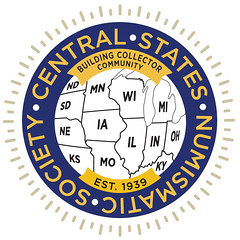 The Newman Numismatic Portal (https://nnp.wustl.edu), based at Washington
University in St. Louis, Missouri, will provide a platform for State Showcase educational
programs. Speakers include representatives of the Iowa Numismatic Association
(http://ina.anaclubs.org), George Cuhaj of the Higgins Museum of National Banknotes in
Okoboji, Iowa (https://TheHigginsMuseum.org), and Notgeld expert Jesse Goplen of
Elkader Auction House in Elkader, Iowa (https://ElkaderAuctionHouse.com).
The Newman Numismatic Portal (https://nnp.wustl.edu), based at Washington
University in St. Louis, Missouri, will provide a platform for State Showcase educational
programs. Speakers include representatives of the Iowa Numismatic Association
(http://ina.anaclubs.org), George Cuhaj of the Higgins Museum of National Banknotes in
Okoboji, Iowa (https://TheHigginsMuseum.org), and Notgeld expert Jesse Goplen of
Elkader Auction House in Elkader, Iowa (https://ElkaderAuctionHouse.com).
I'm super excited about the potential of this new State Showcase concept of
grassroots hobby promotion that we are bringing to the collector community,
emphasized Ernst.
This program was born out of my missing a presentation at the 2022 Nebraska
Numismatic Association dinner. As I drove to Lincoln, Nebraska realizing I was late and
missing a great talk – dinner --, I had an idea. There are probably great numismatic
stories in each of our states,
Ernst recalled.
So, starting this year, we'll celebrate numismatics and the history of the hobby in
each of our thirteen CSNS states beginning with Iowa,
he said.
Founded in 1939, these are the individual states in the CSNS region in alphabetical order: Illinois, Indiana, Iowa, Kansas, Kentucky, Michigan, Minnesota, Missouri, Nebraska, North Dakota, Ohio, South Dakota, and Wisconsin.
After many years in the hobby, I know firsthand how local and state clubs often
labor in the shadows of the hobby, but they all have interesting histories to tell. We want
to give these clubs a chance to tell their stories on a national stage. We want to give our
member states the opportunity to brag about their numismatic history,
stated Ernst.
Additional information about the CSNS 85th annual convention will be announced in the coming weeks and posted online at www.CSNS.org/convention. Information is also available by contacting Convention Manager Cindy Wibker by phone at 407-221-8737 or by email at convention@CSNS.org.
For more information on the Central States Numismatic Society, see:
https://www.csns.org/
For more information on the convention, see:
https://www.csns.org/convention
NUMISMAGRAM MEDAL SELECTIONS: MARCH 3, 2024
Jeremy Bostwick with Numismagram forwarded along these five items from his most recent upload of new material to his site. For all of the new items, please visit https://www.numismagram.com/inventory. -Editor
GREAT BRITAIN. House of Stuart carved bone Plaque. Produced mid-late 18th century (87mm x 73mm, 35.49 g). STVART, four draped busts to left and right, all facing inward: James I (IAMES .I.), Oliver Cromwell (OLIV.), William III (W.), and Mary II (M.) facing right, and Charles I (CHA .I.), Charles II (C .II.), James II (I .II.), and Anne (A.) facing left; all in bas-relief, with stippled background // Blank, though numerous grooves from the carving and smoothing. Edge: Somewhat beveled. Essentially as Made. Almond-ivory in color, with great smoothness and intricacy to the portraits. $1095.
A very interesting and seemingly unique piece on account of its hand-made nature, this bone carving displays the various members of the House of Stuart, along with, rather strangely, Oliver Cromwell, whose interlude with the British Commonwealth saw a brief pause of the monarchy in the mid-17th century. As such, this bears the portraits of the leading figures from the death of Elizabeth I in 1603 to the death of Anne (and the beginning of the House of Hanover) in 1714. Given the use of the "V" for a "U" in STVART, as well as a ligate letter form combining the ME in the name of James I, it would seem that a period of manufacture would lie sometime in the mid-late 18th century.
To read the complete item description, see:
102744 | GREAT BRITAIN. House of Stuart carved bone Plaque.
(https://www.numismagram.com/product-page/102744)
RUSSIA & SWEDEN. Peace of Nystadt (Uusikaupunki) white metal Medal. Issued circa 1770-1825. Commemorating the end of the Great Northern War (59mm, 53.91 g, 12h). By S. Judin. CONCORDI PACE LIGAMUR ("we are joined in harmony through peace..."), Noah's Ark sailing left across Gulf of Finland; in background, city views of St. Petersburg (to left) and Stockholm (to right), joined together under a rainbow; above, dove flies left, with branch in beak; in three lines in exergue, NeopoLI / post beLLI In septentrione / DILVVIVM ("...at Nystadt, after the flood that was the northern war"); ? (artist's signature = Yu [for Judin] to extreme left in water // M.O. P.F. / Principi / PETRO I / Nomine et factis stupendis / MAGNO / Russorum Imperatori / PATRIQUE / Post vicennales triumphos / SEPTENTRIONIS PACATORI / hoc ex auro vernaculo / Numisma / D.D. ("to prince Peter I, great in both name and deeds, emperor and father of the Russians, after twenty years of triumphs, the peacemaker of the north, this base metal medal is offered by decision of the Senate"). Edge: Somewhat beveled as made. Cf. Diakov 57.7 (bronze). Mint State details. Planchet slightly bent—very likely from manufacture; highly lustrous and enticing, and rather scarce; a few stray marks upon the reverse are noted for completeness. $395.
Following studies in Europe, Peter the Great returned to his native Russia with a desire to modernize his nation and turn her into a regional power upon the seas. Previously, Sweden had established herself as a dominant empire within the Baltic, but Peter's successful campaign of various allies ultimately saw a Russian victory in the Great Northern War, albeit after some 20 years. With victory secured through the Treaty of Nystadt, Russia added to her territorial holdings around the Baltic, further establishing her as a serious broker in European affairs going forward.
This medal, designed by Samuel Judin sometime in the later half of the 18th century, revives an earlier type designed at the time of the Treaty. It alludes to the war as the biblical flood, with Noah's Ark sailing under a rainbow, along with a dove overhead, indicative that the longstanding stryfe was finally over. Interestingly, the chronogram on the obverse contains a mistake, as it adds up to 1720, rather than 1721. Of note, the "N" in NeopoLI need not be capitalized, and the "I" in septentrione should be. Chronograms served as an innovative way to bear a date without using numbers. Each capitalized or larger letter in the legend is to be treated and added as a single roman numeral.
An error chronogram! I don't recall seeing another. Nice. -Editor
To read the complete item description, see:
102727 | RUSSIA & SWEDEN. Peace of Nystadt (Uusikaupunki) white metal Medal.
(https://www.numismagram.com/product-page/102727)
UNITED STATES, ITALY & NETHERLANDS. Christopher Columbus/"Danish" white metal Medal. Issued 1893. Commemorating the 400th anniversary of the discovery of America (64mm, 93.46 g, 12h). By N. Fristrup, F. Schmahlfeld & V. Christesen in Copenhagen. CHICAGO 21 OCTBR 1892 / GUANAHANI 12 OCTBR 1492, Columbus and robed female advancing left on deck of ship; radiant star above; compass pattern in border, with directional markings at the top, bottom, left, and right // Eagle, with head left, banner in beak, wings spread, Union shield on breast, and branch and arrows in talons, standing upon ornate rectangular cartouche containing five-line inscription: ESPOSIZIONE UNIVERSALE / CHICAGO 1893 / IN MEMORIA DELL' ILLUSTRE / NAVIGATORE / CRISTOFORO COLOMBO; exposition buildings below, with wreath extending around lower border. Edge: Plain. Eglit 37 var. (bronze); Rulau X11A. Choice Mint State. Extremely lustrous and prooflike, with tantalizing brilliance in the fields. Please view the video in order to see the degree of brilliance evident in the fields. Great artistry, and considered by Joe Levine to be "one of the most attractive of the Columbian medals." Includes part of the original roundelle of issue. $325.
During the lead-up to the quadricentennial of Columbus's initial contact with the New World, numerous medals were designed and struck, both in the United States—in conjunction with the 1893 Columbian Exposition in Chicago—and abroad, sometimes for this event or for similar others. In this case, the so-called "Danish" medal was produced commemorating the quatercentenary.
To read the complete item description, see:
102730 | UNITED STATES. Christopher Columbus/"Danish" white metal Medal.
(https://www.numismagram.com/product-page/102730)
UNITED STATES. James McNeill Whistler bronze Plaque. Issued circa 1905. Commemorating the famous painter and printmaker (89mm x 65mm, 189.07 g, 12h). By V. D. Brenner for the Medallic Art Co. Half-length bust facing slightly left, with head facing and arms on hips; to left, one of his "butterfly" signatures above legend in three lines: JAMES McNEILL WHISTLER / PAINTER ETCHER / AUTHOR // Peacock standing right on branch; to right: "MESSIEURS LES ENNEMIS!" above another of his "butterfly" signatures. Edge: Plain. Smedley 62; Baxter 127; Marqusee 65. Choice Mint State. Olive-bronze surfaces, with a great matte nature; a few scattered and rather inconsequential spots are noted for completeness. Far superior to those that are generally encountered. $545.
Though Brenner would become quite famous numismatically just a few years later with his rendition for the Lincoln cent, he had some other iconic works produced before this ubiquitous design. One such medal is the present piece, which honors the rather defiant and irascible artist, James McNeil Whistler. Often known to accept no differences of opinions or critics, the sparse reverse legend ("Messieurs les Ennemis!") indicates the manner in which he viewed all those who defied him.
Great medal - posing like a peacock, standing out from the crowd. -Editor
To read the complete item description, see:
102699 | UNITED STATES. James McNeil Whistler bronze Plaque.
(https://www.numismagram.com/product-page/102699)
UNITED STATES & GERMANY. Zeppelin silver Medal. Issued 1924. Commemorating the transatlantic flight of the ZR-3/LZ-127 (33mm, 17.95 g, 12h). By K. Goetz in München. ERINNERVNG • AN • Z • R • III • OZEAN FAHRT, airship left over the Santa Maria under sail left upon the seas; D in exergue // DEVTSCHE TATKRAFT / IN 80 STUNDEN, male figure (representing German industry) standing facing, head left, leaning upon hammer and pointing to airship's route on globe; American eagle above; olive branch to left; to right, owl standing facing. Edge: BAYER • HAUPTMÜNZAMT • FEINSILBER. Kienast 321; Hans Kaiser 456. PCGS SP-65. Incredibly vibrant and prooflike, with deep peripheral rings of iridescent toning. Undoubtedly one of the most attractive and eye-catching examples of the type extant. Tied with two others for the top spot in the PCGS census for the lettered edge type, with just three others at the same level (and with none finer there) for the plain edge version. $965.
Zeppelin was a German general and aircraft manufacturer, who later founded the airship company Luftschiffbau Zeppelin. Following Zeppelin's death in 1917, Dr. Hugo Eckener became the head of this company and oversaw post-war fundraising to expand upon its production, even serving as commander for the LZ-127 on numerous occasions. When this airship first entered use, it was the first commercial passenger transatlantic flight service in the world, eventually making 590 flights over nearly a decade. In 1940, she was scrapped for metal for the German efforts in World War II. This type alludes to that first monumental voyage of the LZ-127, along with the explorations of Columbus to the new world over 400 years prior.
Another great medal. I especially like the reverse. -Editor
To read the complete item description, see:
102501 | UNITED STATES & GERMANY. Zeppelin silver Medal.
(https://www.numismagram.com/product-page/102501)
2024 MADISON COUNTY COIN CLUB MEDAL AVAILABLE
Harold Fears of the Madison County Coin Club passed along this update about the club's new medal. -Editor
The 2024 Madison County Coin Club of Huntsville, Alabama Medal
The Madison County Coin Club of Huntsville, Alabama announced that Daniel Carr, proprietor of the Moonlight Mint, has produced silver and copper medals for their club.
The medals are based upon the Saint-Gaudens $20 Double Eagle. The
silver medal is 1 ounce of .999 silver and is edge-lettered with One troy oz.
.999 silver
and a serial number. Only 35 pieces were minted. The other
medal is pure copper, measures 39 mm in size, and bears the same design
except for a smooth edge. Only 50 pieces were minted in copper. Of the
silver medals, only five are remaining, while copper ones have 10 available
for purchase. The silver medals are on sale at $100 each and the copper
medals are $15.
Also available are four error medals, two each in both silver and copper. These rare Daniel Carr error medals will be up for auction during the club's June meeting.
If you are interested in acquiring these medals, send an email to madisoncountycoinclub2020@gmail.com. For more information about the club and this medal, visit the club's website at http://mccc.anaclubs.org/.
To read the earlier E-Sylum article, see:
2024 MADISON COUNTY COIN CLUB MEDAL
(https://www.coinbooks.org/v26/esylum_v26n47a21.html)
STACKS OFFERS SLOVICK INDIAN PEACE MEDALS
Here's the press release for the upcoming Stack's Bowers Galleries sale of the Ronald A. Slovick Indian Peace medal collection. -Editor
Stack's Bowers Galleries Announces Sale of the Ronald A. Slovick Family Collection of Indian Peace Medals
Stack's Bowers Galleries is excited to announce the upcoming sale of the Ronald A. Slovick Family Collection of Indian Peace medals, a highlight of their Spring 2024 Official Auction of the Whitman Coin & Collectibles Spring Expo.
Ronald A. Slovick's interest in this series was sparked in the 1970s by his introduction to a selection of historic
lithographs of Native American chiefs produced by McKinney and Hall in the 19th century. Many of these colorful
prints documented chiefs proudly wearing their Peace medals, and Mr. Slovick was immediately drawn to them. I
was intrigued by the eminence and stature of these chiefs,
wrote Slovick of his initial interest, and the medals were
tangible markers of the interactions between them and the government of the United States. His son also developed
an interest in the medals and, as often is the case, father and son collected with shared enthusiasm. Specimens were
added to the collection across decades, starting with, according to Slovick, a modest bronze medal [that] began a
lifelong pursuit to attain these relics of our American past.
He not only collected the medals, but also became
immersed in their history and developed a fine friendship with Father Francis Paul Prucha, author of a standard
reference on the series.
The collection stands as one of the most important ever assembled, with 23 original medals in silver, 19 of which are
of the American series from George Washington to Ulysses S. Grant. While not complete as to president and size,
this collection must be counted among the most significant Stack's Bowers Galleries has ever offered due to a
singular highlight: a magnificent second size 1795 oval George Washington medal presented at the Treaty of
Greenville. This is a type that few collectors get to see in their lives, let alone have the opportunity to include in their
collections. It is a superb medal offering outstanding quality as well as a remarkable history! Across my 26-year
career in numismatic auctions, this is the first oval Washington Peace medal I have had the chance to research and
catalog,
commented John Pack, Executive Director of Consignments. It is a career highlight.
The Slovick Family Collection also includes other very significant medals notable for their rarity and quality. A medium-size Thomas Jefferson medal, an exceptional entry in any collection, is represented by a very attractive example formerly in the David W. Dreyfuss Collection. Other highlights in the American series include large-size examples of James Madison, James Monroe (a great rarity of the series), John Quincy Adams, James K. Polk (arguably the finest in private hands), Andrew Jackson (ex Captain Andrew Zabriskie), and Abraham Lincoln. A fine selection of bronzes rounds out the offering. The British series is represented by several important offerings, including a prized Lion and Wolf medal and a small-size George III medal that is believed unique in private hands.
COINS OF THE HOUSE OF VALENTINIAN
In a recent CoinWeek article, Mike Markowitz looks at coinage of the late Roman Empire in "The House of Valentinian." Nineteen great coins are pictured along with history of rulers from Valentinian I through Valentinian III and their progeny. Here's a short excerpt - see the complete article online. -Editor
Coins of Valentinian I
Valentinian I. 364-375 CE. AV Solidus (21mm, 4.37 g, 6h). Antioch mint, 6th officina. Struck 365 CE. D N VALENTINI ANVS P F AVG, rosette-diademed, draped, and cuirassed bust right / RESTITVTOR REIPVBLICAE, Valentinian standing facing, head right, holding labarum with right hand and Victory on globe in left; ANTI*. Image: CNG.
Son of Gratianus Funarius, a military officer of humble origin, Valentinian served in the army of Emperor Constantius II (ruled 337-361). He retired to his family estate after he was blamed for a defeat. A devout Christian, he was exiled to Egypt by the pagan emperor Julian, but the emperor Jovian recalled him to service. After Jovian's sudden death, Valentinian was a compromise candidate for the vacant throne. Arriving at the Eastern capital of Constantinople in March 364, he raised his younger brother Valens to the rank of co-emperor.
VALENTINIAN I (364-375). Heavy Miliarense. Thessalonika. Obv: D N VALENTINIANVS P F AVG. Diademed, draped and cuirassed bust left. Rev: VIRTVS EXERCITVS / TES. Emperor standing facing, head left, holding labarum and shield. Image: Numismatik Naumann.
Many of Valentinian's coins were struck at the great Eastern city of Antioch. Constantinople and Thessalonica were also major mints. Coins of Valentinian's 11-year reign in all metals are relatively common and quite collectible, although the gold solidi are often worn, clipped, pierced, or scratched with graffiti. One reference lists 81 types in gold, 73 in silver, and 133 in bronze (Vagi, 290-318).
To read the complete article, see:
The House of Valentinian: CoinWeek Ancient Coin Series
(https://coinweek.com/the-house-of-valentinian-coinweek-ancient-coin-series/)
OXFORD POUND OFFERED
Baldwin's is offering a rare Oxford Pound for sale. David Pickup passed along this article. Thank you. -Editor
A historic coin pressed in Oxford is up for auction next month and is expected to sell for thousands of pounds.
The rare item is an Oxford half pound which dates back to 1643 when it was created in the city's mint.
It depicts King Charles I on horseback, crowned and in full armour raising a sword while on the reverse is the abbreviated form of Charles's oath made at Wellington in September 1642.
This is when he declared that he would protect the Protestant Religion, the Laws of England and the Liberty of Parliament.
Oxford enters the story in 1642 after Charles I lost control of London during the Civil War and moved to the city in November.
He took over Christ Church College as his Royal residence and billeted his soldiers throughout the city.
The university was supportive of the Royalist cause and donated its silverware to Charles and the king had set his mint up in December.
To read the complete article, see:
King Charles I: Rare Oxford coin up for thousands at auction
(https://www.oxfordmail.co.uk/news/24139431.king-charles-rare-oxford-coin-thousands-auction/)
1723 SOUTH SEA COMPANY SHILLING
From the website offerings of CoinCraft in London is this nice 1723 George I South Sea Company Shilling. -Editor
George I, Shilling, 1723 SSC Extremely Fine
The South Sea Company (SSC) was a British joint-stock company founded in 1711. It was created to reduce the cost of the national debt. The company stock rose greatly in value as it expanded its operations dealing in government debt, and peaked in 1720 before suddenly collapsing, it ruined thousands of investors, and became known as the South Sea Bubble. Coinage of the South Sea Company was minted in Britain in 1723, after they discovered silver in Indonesia in 1722. Just over 300 years later, we're delighted to offer you this beautiful SSC
shillings in very high grade, limited numbers only.
To read the complete item description, see:
George I, Shilling, 1723 SSC Extremely Fine
(https://coincraft.com/george-i-shilling-1723-ssc-extremely-fine)
Coincidentally, yesterday's Wall Street Journal mentioned the South Sea bubble in an article about how today's bull stock market has a ways to go before entering traditional bubble territory. -Editor
The great bubbles of the past were quite different, involving massive speculation driving up valuations (Japan's entire market traded at 50 times forward earnings at its 1989 peak). At the extreme, wild optimism turned into the purest form of speculation. Stocks became no more than gambling chips used in a pure Ponzi scheme of selling to a new buyer.
Stock promoters also raced to create new companies to satisfy the demand from buyers desperate to buy into the fashionable story. In all the big bubbles booming stock prices were accompanied by an IPO boom, perhaps taken to the extreme in the 1720 South Sea bubble. Gullible buyers were tempted by new companies raising cash for projects including ships full of water to carry live fish (the fish died); a flintlock machine gun that fired square bullets (too unreliable); and extracting saltpeter from waste collected from lavatories in England, according to historian Edward Chancellor's Devil Take the Hindmost.
To read the complete article, see:
A Frothy Market Misses Vital Bubble Ingredients
(https://www.wsj.com/finance/stocks/a-frothy-market-misses-vital-bubble-ingredients-510efbaf)
To read an earlier E-Sylum article, see:
HIDDEN IMAGES: THE RAT HALFPENNY
(https://www.coinbooks.org/esylum_v17n04a12.html)
KING CHARLES III 2024 MAUNDY COIN PLANS
An article published last week looks ahead to this year's Maundy ceremonies. -Editor
Every year in the UK a Maundy Service occurs on the Thursday before Easter and each year, the British Monarch distributes silver coins to chosen men and women.
Early in her reign, Queen Elizabeth II decided that the money should not just be handed out in London and every year she travelled to a different Cathedral for the service.
During the service, the Sovereign distributes gifts according to the number of years they have lived with the same number going to both men and women.
Last year, King Charles III arrived at York Minster to distribute the first Maundy Coins of his reign and each of the 74 men and 74 women received two purses, one purse made from white leather, holding coins to the value in pence of King Charles III's age. The other purse is made from red leather, containing a £5 and 50p.
Those produced are in denominations of 1p, 2p, 3p and 4p and although legal tender are not expected to be used although there is a significant collector market for these coins and sets of just four coins tend to sell for around £250.
This year, assuming that King Charles III is fit enough to take part in the Maundy Service, the number of recipients will be 75 rather than 74 of each sex and if he can't attend then it is expected that the Prince of Wales will stand in for him.
To read the complete article, see:
Maundy Money issued by British Monarch
(https://euroweeklynews.com/2024/02/26/maundy-money-issued-by-british-monarch/)
BINION 1934 $10,000 BILL OFFERED
Stack's Bowers Galleries Currency Auction Associate Bradley C. Trotter wrote about their upcoming sale of a Binion million dollar display note. -Editor
Among the most well-known stories in the history of American currency is that of Benny Binion and his hoard of 1000 Series of 1934 $10,000 Federal Reserve Notes. For nearly 35 years these were housed inside of a golden horseshoe display at Binion's Horseshoe Casino (now Binion's Gambling Hall and Hotel) in Las Vegas. Assembled in 1964 and broken up in 1999, each individual note in the display represented a titanic sum of money at the time; these notes were primarily intended to be used to transfer large sums of money between banks.
Today a rare sight even among the inventories of established auction houses and major dealers, $10,000 Federal Reserve Notes have long been sought after by collectors seeking to assemble an impressive collection of high denomination notes. The presence of a $10,000 hailing from Binion's display in lot 21377 in our upcoming Spring 2024 Showcase Auction is sure to generate excitement among collectors and dealers alike.
More attractive than most offered at auction, this example faces up well as it never entered circulation. Free from internal damage, there is evidence of restoration, typical for many Binion notes due to how they were displayed. This is of trifling concern when weighed against the historical significance of the Binion notes and the desirability of the $10,000 denomination.
The plate impression is bold and fully framed with sharp details seen in Chase's portrait at center. The engraved details make an exceptional contrast against the creamy paper and vivid overprint. Only 100 of these Binion notes are available to collectors and surely more collectors desire to own one. Here is your opportunity to secure a legendary piece of numismatic lore.
The Binion family's story is a long and sad one, involving not just high-denomination notes, but silver dollars, robbery and murder. See our earlier articles for more. -Editor
To read the complete article, see:
BINION DISPLAY $10,000 FEDERAL RESERVE NOTE TO BE OFFERED IN SPRING 2024 SHOWCASE AUCTION
(https://stacksbowers.com/binion-display-10000-federal-reserve-note-to-be-offered-in-spring-2024-showcase-auction/)
To read earlier E-Sylum articles, see:
ARTICLE TRACES HISTORY OF LAS VEGAS' MILLION-DOLLAR MONEY DISPLAY
(https://www.coinbooks.org/esylum_v12n48a17.html)
VERDICT IN BINION CASINO MURDER CASE
(https://www.coinbooks.org/esylum_v13n05a16.html)
TED BINION AND THE BINION SILVER DOLLAR HOARD
(https://www.coinbooks.org/v21/esylum_v21n32a19.html)
BINION HORSESHOE CASINO DISPLAY $10,000 NOTE
(https://www.coinbooks.org/v24/esylum_v24n04a35.html)
NOTES FROM E-SYLUM READERS: MARCH 8, 2015 : The Old Binion's $Million Display
(https://www.coinbooks.org/esylum_v18n10a09.html)
$100 BILL, AMERICA'S MOST ANNOYING CURRENCY
Len Augsburger passed along this Wall Street Journal about people hating on the hundred. Thanks. -Editor
For all its prevalence, the $100 bill is more effective for storing money than spending it. Even when cashiers do accept the bills, they hold up checkout lines to verify they aren't counterfeits. (Or, at minimum, give an eye-roll along with your change.) Economists have called for slowing down the printing press, due to their use in illicit activity.
Everyone almost questions you and your legitimacy for using a $100 bill,
said Sage Handley, 23.
Handley, who works as a marketing and research assistant in College Station, Texas, found a $100 bill in an old makeup bag earlier this month. She posted on TikTok about the embarrassment of spending it, one of many social-media posts mocking the awkwardness of paying for a small item with a $100 bill.
 In Midtown Manhattan, cashiers were on alert when a Wall Street Journal reporter tried to use $100 bills to pay for small items. Some held the bill up to the light to spot
In Midtown Manhattan, cashiers were on alert when a Wall Street Journal reporter tried to use $100 bills to pay for small items. Some held the bill up to the light to spot USA 100
embedded in it to confirm its authenticity. Others used a counterfeit pen, which has ink that turns black when in contact with fake currency.
At a bookstore, a cashier yelled check, please
and an employee appeared from behind a tall stack of books to run a $100 bill through a counterfeit bill detector before completing a transaction for $3 of children's books. The store had recently caught a customer trying to use a fake $100.
At a nearby vegan restaurant, a $100 bill was rejected as payment for a $4.95 bottle of kombucha. The store didn't have enough cash in the register. Another customer had walked out that day because the restaurant wouldn't accept the bills, a staffer said.
 Some 60% of all payments are made with debit or credit cards, according to Federal Reserve data. Cash use dropped sharply during the pandemic in 2020, and it hasn't fully recovered. Today, cash is the third-most used payment method in the U.S. by number of transactions.
Some 60% of all payments are made with debit or credit cards, according to Federal Reserve data. Cash use dropped sharply during the pandemic in 2020, and it hasn't fully recovered. Today, cash is the third-most used payment method in the U.S. by number of transactions.
Conner Morton isn't complaining. The director of operations at Prineta, a Kansas City-based company that stocks ATMs, said the company has been loading more ATMs with $100 bills lately. The note is especially popular among ATMs in barbershops, tattoo shops, hotels and convenience stores.
It's five times less work to load the $100 bills than five $20s,
Morton said.
My local ATM constantly offers up $100 bills, which I decline in favor of the easier-to-spend $20s. I wouldn't mind $50s, but the machines don't offer those. -Editor
To read the complete article, see:
The $100 Bill Is America's Most Common Currency, and Its Most Annoying
(https://www.wsj.com/personal-finance/american-dollar-currency-100-bill-c6a47c79)
SO WHO'S USING ALL THE CASH?
A related Business Insider article asks, "Cash is no longer king. So why are we still printing so much?" -Editor
Federal Reserve data shows that the volume of currency in circulation has only increased since 2002. Every denomination — including less common banknotes such as the $2 bill — has increased in circulation, from the humble dollar to the Benjamins. As of December 31, there were 54.1 billion notes in circulation compared to 22.9 billion notes in 2002.
Economics experts say that despite increasing reliance on cards, cash remains resilient and an important payment method for many consumers.
"Cash still remains really important to certain segments of consumers," Christopher Bechler, assistant professor of marketing at the University of Notre Dame Mendoza College of Business, told Business Insider, pointing to underbanked customers as one segment of the population who rely on cash.
Underbanked consumers often refer to people with bank accounts who rely on alternative financial services such as non-bank money orders or payday loans.
Bechler said that cash also tends to be a preferred payment method for smaller purchases under $10 or "hard-to-justify" items, referring to "guilty" purchases that aren't necessary, like an overpriced water bottle at an airport or cigarettes.
In his 2023 study published in the Journal of the Association for Consumer Research, Bechler found that consumers "pay with card to remember and cash to forget" because the latter method won't leave a paper trail of their purchases.
"This pattern is strongest for consumers who diligently track their card spending and occurs because consumers don't want to see records of their unjustifiable spending," Bechler told BI.
To read the complete article, see:
Cash is no longer king. So why are we still printing so much?
(https://www.businessinsider.com/why-fed-us-print-more-money-cash-preferred-payment-method-2024-2)
THE BIRTH OF A (PSEUDO) CURRENCY
This article, found via News & Notes from the society of Paper Money Collectors (Volume IX, Number 36, February 20, 2024), provides a great discussion on the market dynamics and lifecycle of substitute currencies. -Editor
A dozen pseudo-currencies were issued in Argentina in 2002. How did that work? And why are they coming back in 2024?
What is a pseudo-currency? How do they start? Why do they have value?
Here is a Bono Patacon, emitted by the province of Buenos Aires:
And here are some other designs from Buenos Aires and other provinces
As a province you don't have the legal authority to issue "real" pesos. So, this is technically a bond but you hope people will accept it as pesos, because that is what people want.
The utilities are accepting the bonds because you forced them to.
The workers have no choice so they take what you give them, hoping they'll be able to spend these bonds somehow.
Months go by and there are a lot of bonds circulating. Workers always try to pay first with the bonds, and only later with the relatively scarcer pesos. This is called Gresham's law: bad money drives out good money.
This results in the baker receiving more bonds than it needs to pay for taxes and utilities. When he tries to pay for flour with them, the supplier rejects it because he too has too many bonds. They negotiate and the supplier is willing to accept bonds at a 5% discount to pesos. So, if flour was ARS 100 per kilogram, the baker has to pay 105 bonds for it.
To reflect this, the baker sets a sign in their store "Bonds accepted at 0.95". The other bakers all have the same problem, so they do the same.
Your pseudo-currency now has an exchange rate, given by the "market". This is a very decentralized market with no clearing house. Instead, each gas station, grocery store, hair salon, etc decides how many bonds to accept and at what rate. But if anybody of them undervalues the bonds with respect to the market, their customers go to the competition.
This goes on until your provincial government or the federal government has enough pesos to exchange for the bonds. One way this can happen is when the federal government agrees to start printing pesos again. When you own the printer, everything is possible. Then, when the government starts trading pesos for bonds, everybody rushes to convert them, and they quickly disappear.
Your pseudo-currency doesn't exist anymore.
To read the complete article, see:
The birth of a (pseudo) currency
(https://blog.sbensu.com/posts/pseudo-currencies/)
LOOSE CHANGE: MARCH 3, 2024
Here are some additional items in the media this week that may be of interest. -Editor
Jeffry Johnson passed along this article about the chance discovery of Nikola Tesla's head - a bronze bust of the famed inventor. -Editor
 Lou Rebrovic typed his last name into Google this weekend hoping to find some long-lost relatives to connect with now that he is retired.
Lou Rebrovic typed his last name into Google this weekend hoping to find some long-lost relatives to connect with now that he is retired.
Instead, he may have made a break in a mystery that has baffled his family and thousands of Clevelanders for nearly a decade: Who stole Nikola Tesla's head?
Or, more precisely: Who stole a bronze bust of Tesla that disappeared from its pedestal in the Cleveland's Serbian Cultural Garden in 2014?
Rebrovic said he was shocked when he saw one of the first results the search engine spat out: a listing on LiveAuctioneers.com, a popular auctioneering website that allows galleries and private individuals to list works of art for online auction.
When he saw the picture, Rebrovic instantly recognized it as the famed Serbian-American inventor whom his father, Matthew Louis Rebrovic, sculpted and gifted to the garden for its 2008 dedication.
I thought, ‘Oh my God, that's dad's statue,'
Rebrovic recalled in a phone interview Monday.
Interesting story regardless, although I've come up empty looking for a numismatic connection for sculptor Matthew Louis Rebrovic. Often sculptors of busts and statues also create medals. Can anyone find a connection? -Editor
To read the complete article, see:
Who stole Nikola Tesla's head? Bust taken from Cleveland's Cultural Gardens emerges at online auction after missing for 10 years
(https://www.cleveland.com/court-justice/2024/02/who-stole-nikola-teslas-head-bust-taken-from-clevelands-cultural-gardens-emerges-at-online-auction-after-missing-for-10-years.html)
CDN Publishing reported on a new website for information on European coins. -Editor
 The field of numismatics has not been left out from the influence of technological development. Polish startup Coinstrail.com presents a new tool for collectors — a price guide and catalog of coins of European countries. For a nominal fee of $5 per month, users can access an online catalog covering coins from countries such as Poland, Germany (since 1800), Russia, and several others.
The field of numismatics has not been left out from the influence of technological development. Polish startup Coinstrail.com presents a new tool for collectors — a price guide and catalog of coins of European countries. For a nominal fee of $5 per month, users can access an online catalog covering coins from countries such as Poland, Germany (since 1800), Russia, and several others.
The Coinstrail.com price guide contains valuable information about the value of coins depending on their condition, presented in an easy-to-understand Sheldon scale. In total, the catalog contains data on 18,756 types of coins from different countries and periods, which allows you to accurately identify a coin. More than 300,000 records of coin auction sales allow you not only to evaluate a coin, but also to identify price trends and find the sale history of a particular coin. For certain countries, such as Poland and Russia, the catalog provides data on sales of coins from famous collections of the 20th century, which is a valuable source for finding the origin of coins.
To read the complete article, see:
Coinstrail.com Is a Tool For Valuing and Researching European Coins
(https://www.greysheet.com/news/story/coinstrail-com-is-a-tool-for-valuing-and-researching-european-coins)
Another CDN Publishing report provides results of the NFL's auction of this year's Super Bowl flip "coin." -Editor
On February 28, the NFL concluded an online auction for the coin (actually a token) that was flipped to determine the first possession in overtime. This token played a large part in the event to follow in one of the most exciting finishes in Super Bowl history. The token sold for an amazing $26,300, with proceeds to benefit Luna Strong's Maui relief fund to assist the numerous youth athletic programs that suffered during the tragic fire.
To read the complete article, see:
Token Used for Super Bowl 58 Coin Flip Sells in Charity Auction for $26,300
(https://www.greysheet.com/news/story/token-used-for-super-bowl-58-coin-flip-sells-in-charity-auction-for-26300)
To read the earlier E-Sylum article, see:
NUMISMATIC NUGGETS: FEBRUARY 4, 2024 : Super Bowl LVIII Flip Coin
(https://www.coinbooks.org/v27/esylum_v27n05a20.html)
DELHI MAN SWALLOWS 39 COINS... AND MORE!
Last week, it was an alligator. Now this. Kavan Ratnatunga passed along this bizarre story from India. Thanks. -Editor
Delhi man swallows 39 coins, 37 magnets to 'build his body'
A Delhi man swallowed 39 coins and 37 magnets after presuming that the zinc content in the former would help him in bodybuilding, When doctors asked him why he had consumed the coins and magnets, he said he thought the zinc content, in the former, would help build his body. He also said that the magnet would ensure the coins remained in the intestine and assist in absorbing the zinc.
The surgery was performed after the patient complained of abdomen pain for 20 days.
The patient, who lives in Delhi, was discharged from the hospital two days ago after a week of post-surgery hospitalisation.
Kavan adds:
"One amusing fact is that Zinc is not magnetic."
The 'gator ate 70 coins. 39 plus 37 is 76 objects, but I'll only count coins and give this round to the reptile. -Editor
To read the complete article, see:
Delhi man swallows 39 coins, 37 magnets to 'build his body'
(https://timesofindia.indiatimes.com/city/delhi/delhi-man-shwallows-39-coins-37-magnets-to-build-his-body/articleshow/108026423.cms)
To read the earlier E-Sylum article, see:
LOOSE CHANGE: FEBRUARY 25, 2024 : Coins Removed from Alligator's Stomach
(https://www.coinbooks.org/v27/esylum_v27n08a34.html)



